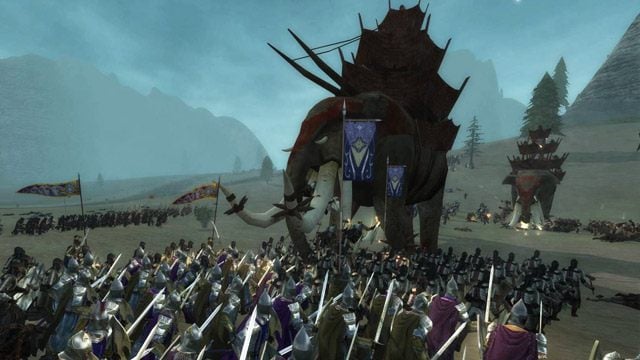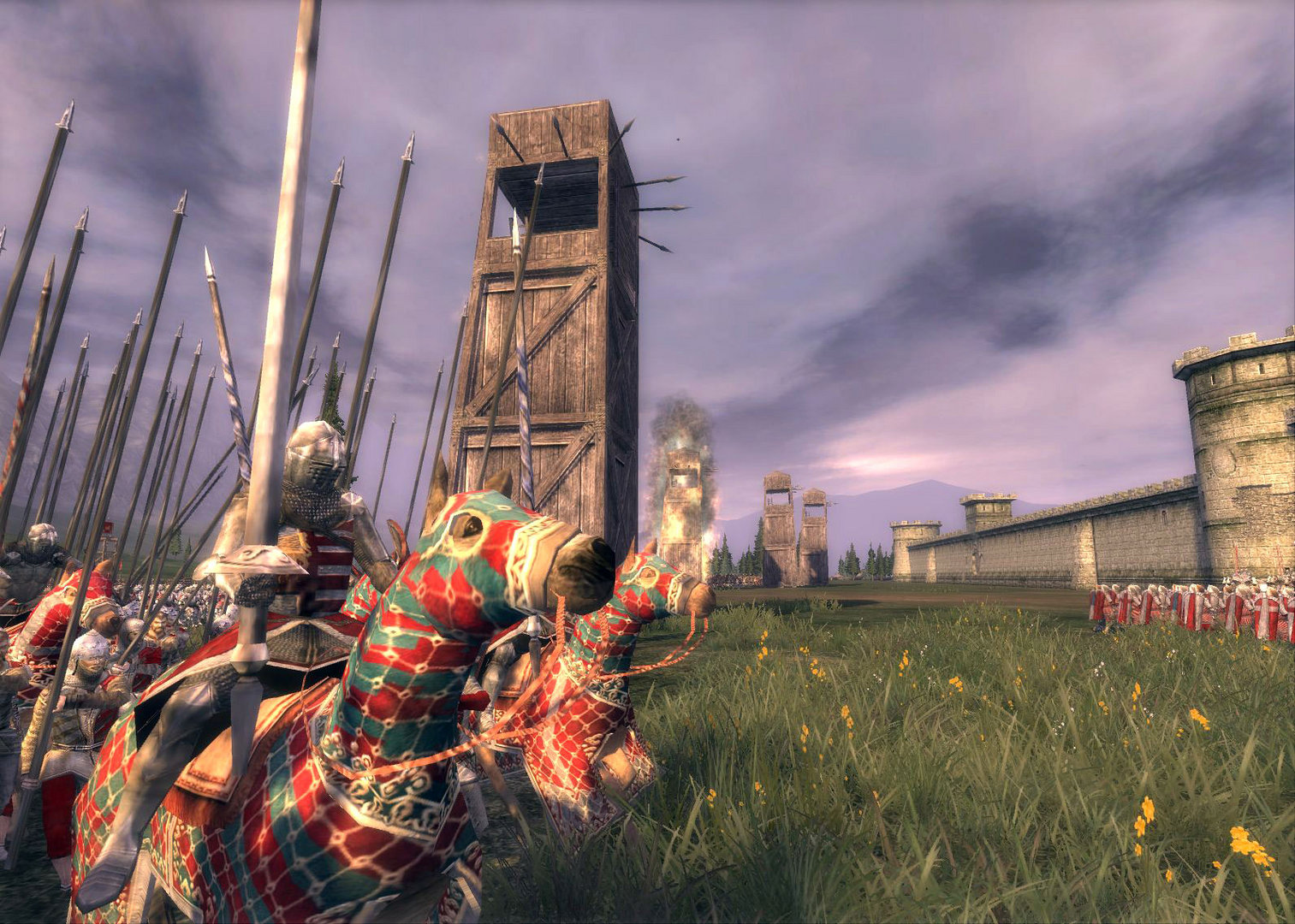DLGamer allows you to download Total War: MEDIEVAL II – Definitive Edition, legally and securely. Official distributor and partner of major publishers, we are committed to bring you the best prices on Steam, Origin and Gamecards keys always focusing on providing quality customer service, 7 days a. Medieval II: Total War - Kingdoms - Divide and Conquer v.4.5 Eriador Rises - Game mod - Download The file Divide and Conquer v.4.5 Eriador Rises is a modification for Medieval II: Total War - Kingdoms, a(n) strategy game. Complete your Total War collection with this Definitive Edition of Total War: MEDIEVAL II, which includes all DLC and feature updates since the game’s release: Kingdoms is the most content-rich expansion ever produced for a Total War game, with four new entire campaigns centred on expanded maps of the British Isles, Teutonic Northern Europe.
| Medieval II: Total War | |
|---|---|
| Developer(s) | Creative Assembly Feral Interactive(OS X, Linux) |
| Publisher(s) | Sega Feral Interactive (OS X, Linux) |
| Director(s) | Robert T. Smith |
| Designer(s) | Robert T. Smith Dan Lehtonen |
| Composer(s) | Jeff van Dyck Richard Vaughan James Vincent |
| Series | Total War |
| Platform(s) | Microsoft Windows, OS X, Linux |
| Release | Microsoft Windows
|
| Genre(s) | Real-time tactics, Turn-based strategy |
| Mode(s) | Single-player, multiplayer |
Medieval II: Total War is a strategyvideo game developed by The Creative Assembly and published by Sega. It was released for Microsoft Windows on 10 November 2006. Feral Interactive published versions of the game for macOS and Linux on 14 January 2016.[1] It is the sequel to 2002's Medieval: Total War and the fourth title in the Total War series.
Gameplay is divided between a turn-based strategic campaign and real-time tactical battles. The campaign is set between the years 1080 and 1530. Players assume control of a medieval state, referred to in the game as a faction, and control its government, economy, military, diplomacy, and religion on a map spanning most of Europe, North Africa, and the Middle East. In battles, players control groups of soldiers and engage in combat with enemy forces.

Medieval II received mostly positive reviews from critics. Many reviewers regarded the game as an improvement over its predecessors, but criticized its lack of innovation. An expansion pack, Medieval II: Total War: Kingdoms, was released in 2007.
Gameplay[edit]
Similarly to previous titles in the Total War series, Medieval II: Total War consists of two main modes of play: a campaign mode and battles.
Medieval 2 Total War Kingdoms Units
Campaign[edit]
The campaign, which is turn-based, allows the player to play as one of seventeen factions from the time period and build their nation economically and militarily in order to conquer other factions. Gameplay consists of controlling the faction's military, economic, and social systems in large campaign maps. During the player's turn, armies, fleets, and agents can be moved on the map. When an army engages another army, the player can choose to fight the battle personally in the battle mode, or automatically calculate the outcome.[2]
The goal of the campaign depends on which type of campaign is played. The short campaign requires the player to defeat one or two enemy factions and control at least 15 settlements. The long campaign requires the player to control at least 45 territories and one or two significant cities, such as Jerusalem, Granada, Rome or Constantinople.[3]

Territorial control in the campaign is represented by 'settlements', which are large, notable communities. Unlike in previous Total War games, there are two different types of settlements: castles and cities. Cities primarily focus on buildings that boost one's economy, while castles primarily focus on buildings that allow for the recruitment of more advanced types of soldiers. Certain buildings in settlements can also allow the player to recruit agents that fulfill certain functions, like diplomats and spies. Under most circumstances, the settlements can be converted from one type to the other. Settlements can be governed by members of the player's family, who are also capable of leading armies as generals. The talents of family members (and other key characters) are affected by various statistics, like 'Piety' and 'Loyalty', which are in turn impacted by their character traits, personal experiences, and members of their personal retinue. For example, a character with a high 'Command' stat can be expected to do better in battle than a character with a low stat.[3]
Religion in the game is divided into three primary faiths: Roman Catholicism, Eastern Orthodoxy, and Islam. Unorganized pagan faiths and heretical sects are also represented. If a large portion of a settlement does not adhere to the state religion, unrest may ensue. Missionaries and religious buildings can be used to gradually convert members of other faiths to the state religion. Catholic nations must deal with the Pope, who can send special missions to Catholic rulers. Failure to obey the Pope may result in excommunication. The Pope may also call Crusades against hostile settlements. Muslim imams with a high 'Piety' stat may similarly declare jihads.[4]
Factions primarily interact with each other through diplomacy. Diplomatic actions include the creation of alliances, the securing of trade rights, and the giving or receiving of tribute. Factions may go to war with one another to secure more settlements or other concessions. Factions that are at war can use their armies to fight each other, which incorporates the battle mechanic of the game into the campaign. Several factions in the campaign are either not present or 'dormant' when the game begins. The Mongols will invade at some point after the campaign has begun, often posing a serious threat to factions in their path. Later on, the Timurids will also invade, bringing war elephants with them. Late in the game, factions may also sail to the Americas, where they can encounter the Aztecs.[5][6]
Battles[edit]
One of the main focuses on the Total War franchise is its representation of real-timebattles in addition to the turn-based campaign. A battle consists of two or more armies from different factions fighting each other. Battles play similarly to those in Rome: Total War, with formations of various kinds of troops engaging in combat. The objective of the battle is to defeat the enemy army by completely destroying it or causing the whole army to flee; in a siege battle, the objective is to completely destroy the army or to take control of a plaza in the centre of the settlement. There is also an option which allows the player to allow for time limits on battles, meaning that the attacker must defeat the defender within a certain time limit or the battle results in a victory for the defender. Battles can exist as custom battles set up by the player, multiplayer battles between humans, historical battles based on real-life military engagements, or battles that occur between factions in the campaign.[3][6]
Reception[edit]
| Reception | ||||||||||||||||||||||
|---|---|---|---|---|---|---|---|---|---|---|---|---|---|---|---|---|---|---|---|---|---|---|
| ||||||||||||||||||||||
Medieval II: Total War received a 'Gold' sales award from the Entertainment and Leisure Software Publishers Association (ELSPA),[11] indicating sales of at least 200,000 copies in the United Kingdom.[12]
Medieval 2 Total War Download

Medieval II: Total War received 'generally favorable reviews' according to the review aggregation website Metacritic.[7]
The exclusive review was given to PC Gamer (US), which gave it an 'Editor's Choice Award'.[10]IGN said that the game was not as revolutionary as its predecessor, but still introduces some new ideas and builds on others from Rome: Total War, which would still be enough for anybody to buy it.[6]GameSpot noted the game's 'epic, engrossing gameplay', but also criticised its 'beefy system requirements'.[3]Hyper's Anthony Fordham commended the game for its 'incredible gameplay, both in battle and on the world map.' However, he criticised it for being 'more a refinement of the series than a huge leap forward.'[13]
Swedish historian and member of the Swedish AcademyPeter Englund reviewed the game for Swedish newspaper Dagens Nyheter where he made comparisons to traditional battle depictions such as old copper engravings and paintings, and the more recent film medium. In the review, Englund concluded that Medieval II represents a form of battle depiction 'amazingly similar to an engraving from the 1600s.'[14]
The editors of Computer Games Magazine named Medieval II the eighth-best computer game of 2006. They wrote that 'No scripted encounters or overly dramatic cutscenes can compare with the stories Creative Assembly allows you to write as your armies beat down all who would oppose you.'[15]Edge ranked the game at #26 on its list of 'The 100 Best Games To Play Today', calling it 'as complete a depiction of war as there has been in a videogame.'[16]
Although most reviews were positive,[3] some reviews have noted negative aspects of the game, such as pathfinding bugs,[17] some AI problems and some uninteresting new features.[9]
Expansion[edit]
An expansion, Medieval II: Total War: Kingdoms, was announced on 30 March 2007 and released on 28 August 2007 in the US, 31 August in the UK, 7 September in Australia, and 22 November in Japan. It adds four new campaigns to the game: 'Americas', which focuses on the Spanish colonization of the Americas, 'Britannia', which focuses on several conflicts on the British Isles, 'Crusades', which covers the Third and Fourth Crusades, and 'Teutonic', which deals with the Northern Crusades. In each of the campaigns, a small part of the world (e.g. the British Isles) is taken and enlarged, with many settlements added to it.
The Gold Edition of the game, containing the original game and the expansion pack, was released on 1 February 2008; this was later released/renamed on Steam as Medieval II: Total War™ Collection.
References[edit]
- ^'The Medieval II: Total War™ Collection gallops to Steam for Mac and Linux on January 14th'. Feral Interactive. Feral Interactive. Retrieved 3 November 2017.
- ^ abMeer, Alec (13 November 2006). 'Medieval 2: Total War'. Eurogamer. Retrieved 26 July 2016.
- ^ abcdefOcampo, Jason (14 November 2006). 'Medieval 2: Total War Review'. GameSpot. Retrieved 26 July 2016.
- ^Toose, Dan (6 September 2006). 'Medieval 2: Total War Designer Diary #4 – Religion'. Gamespot. Retrieved 1 April 2019.
- ^Toose, Dan (24 July 2006). 'Medieval War II : Total War : Developer Diary'. Hexus. Retrieved 1 April 2019.
- ^ abcdeButts, Steve (8 November 2006). 'Medieval II: Total War UK Review'. IGN. Retrieved 27 July 2016.
- ^ ab'Medieval II: Total War for PC Reviews'. Metacritic. Retrieved 26 July 2016.
- ^Ferris, Duke (15 December 2006). 'Medieval II: Total War Review'. Game Revolution. Retrieved 26 July 2016.
- ^ abKosak, Dave (17 November 2006). 'GameSpy: Medieval II: Total War'. GameSpy. Retrieved 14 March 2009.
- ^ ab'Medieval II: Total War'. PC Gamer: 28. December 2006.
- ^'ELSPA Sales Awards: Gold'. Entertainment and Leisure Software Publishers Association. Archived from the original on 19 March 2009.
- ^Caoili, Eric (26 November 2008). 'ELSPA: Wii Fit, Mario Kart Reach Diamond Status In UK'. Gamasutra. Archived from the original on 18 September 2017.
- ^Fordham, Andrew. 'Medieval II: Total War'. Hyper. Next Media (159): 54–55. ISSN1320-7458.
- ^Englund, Peter (24 November 2006). 'Medieval II: Total War'. Dagens Nyheter.
- ^Staff (March 2007). 'The Best (and Worst) of 2006; The 16th Annual Computer Games Awards'. Computer Games Magazine (195): 46–51.
- ^Edge staff (9 March 2009). 'The 100 Best Games to Play Today (Page 8)'. Edge. Archived from the original on 26 September 2012. Retrieved 26 July 2016.
- ^Molloy, Sean (January 2007). 'Medieval 2: Total War'. Games for Windows: The Official Magazine (2). Archived from the original on 6 June 2016. Retrieved 26 July 2016.
External links[edit]
- Medieval II: Total War at MobyGames
| Wikiquote has quotations related to: Medieval II: Total War |
